| Introduction
Supply is of prime importance to an
Army in the field, without it an Army is soon rendered ineffective.
History tells us that many a campaign has been lost because of a lack of
supplies. To prevent such a situation occurring the British Army raised
a Corps of Wagoners, to fulfil this role as early as 1794.
History
The history of the Royal Australian
Army Service Corps began in Australia in 1886 when Victoria raised an
Ordinance and the Commissariat and Transport Corps of Victoria was
formed. This Corps was made up of militia and continued until 1889 when
the ordnance functions of the corps were dropped and it was redesignated
as the Commissariat and Transport Corps of Victoria. New South Wales
(NSW) followed suit and on 01 January 1891 the Commissariat and
Transport Corps of NSW was formed. The Army Service Corps was formed in
England in 1888 and in NSW on 23 November 1893. Shortly after Victoria
followed and late in 1895 retitled their corps to the Victorian Army
Service Corps.
- Shortly after Federation (01
January 1901) the Australian Army Service Corps (MSC) was formed.
World War One (WWI)
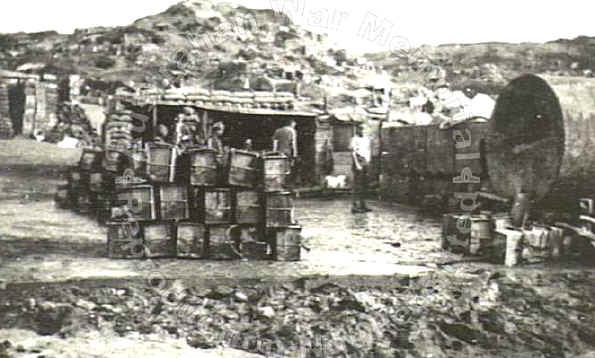 |
|
Anzac.
No. 2 outpost Australian Army Service Corps dugouts.
|
The AASC saw service in WW1 at
Gallipoli, in Europe with the British Expeditionary Force, Egypt and
with the ANZAC Divisions in France. In all areas men of the MSC provided
an invaluable service to the fighting troops and the Corps was well
commended for its efforts. Out of a total of 331,781 men of the AIF who
embarked in Australia for overseas, 9,735 were AASC personnel.
 |
| Members
of a horse transport unit of the Australian Army Service Corps and
their teams at an Army depot on the Salisbury Plain. |
- A total of three officers and 38
other ranks were killed in action, four officers and 57 other ranks
died of wounds and a further 16 officers and 593 other ranks were
wounded in action, 34 were gassed.
Between the wars 1919 - 1939
During this period the AASC (MSC) did
not rate particularly high in military minds and consequently was
reduced to a few militia units. The regular compliment of these units
consisted mainly of small cadres of regular quartermasters and warrant
officers of the Australian Instructional Corps.
In 1933 a decision was made to
mechanise the MSC and by 1938 the Corps was equipped with Chevrolets,
30cwt for second (formation) line work and 3 ton for third (force) line
work. The total MSC Motor Transport vehicles in 1939 were approximately
100. Prior to World War Two the MSC was prepared neither in numbers nor
equipment for wartime tasks and was largely untrained in almost every
aspect of its specialist functions.
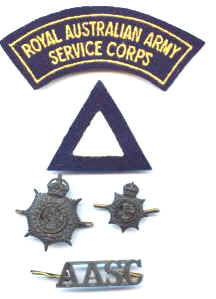 |
Units possessed few vehicles and most
of these were outdated and unsuitable, equipment was at a premium. There
were no depots for supplies, only inadequate drill halls and makeshift
buildings.
Furthermore, there were no specialist units to bake bread,
butcher and distribute meat, hold supplies in cold storage, receive and
distribute petroleum, oils and lubricants.
Marine food supply platoons,
workshops and laboratories had yet to be raised, agricultural farms and
petroleum storage farms were units of the future, as were air
maintenance and amphibious companies (air supply and the use of
amphibians had not been envisaged at this stage). |
Not only were none of these units
raised on the Australian Order of Battle but there were no specialists
on strength to man them if they had been. Finally, to top it all off,
there was a serious deficiency in trained AASC officers. This was the
state of the AASC when, on 3rd September 1939, England declared war on
Germany and WWII commenced
World War Two (WWII)
 |
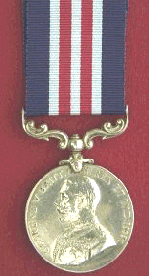
|
| Military
Medal "For Bravery in the Field".
Note this image bears the likeness of an earlier Sovereign |
| Driver
E E Webb, Australian Army Service Corps attached 2/3rd Australian
Field Ambulance, receiving the ribbon of the Military Medal from
Lieutenant-General Sir Leslie Morsehead,
General-Officer-Commanding A.I.F. (Middle East) at a parade at
headquarters, 9th Australian Division. |
During the war the AASC (MSC) saw
service on all fronts. The best remembered is the role played by the
Corps in supporting the 9th Australian Division in the defence of
Tobruk. It was there that General Morsehead ordered the MSC to form an
infantry battalion thereby authorising its soldiers to draw bayonets.
The MSC could not provide a mortar company and subsequently provided
four MSC companies, which were utilised as infantry.
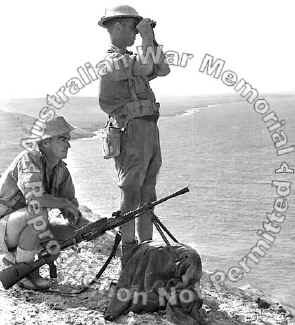 |
One of these companies served on the
eastern edge of the defence perimeter for six months without relief
thereby giving them the distinction of gaining the longest, continuous
period of service on front line duty in the Siege of Tobruk.
Later these
same troops distinguished themselves in the Battle of El Alamein (1942)
where, performing their normal corps role, they sustained the 9th
Australian Division throughout that momentous operation.
- Today the home of the RACT at
Puckapunyal bears the name Tobruk Barracks.
|
| Tobruk, North Africa,
1941-09-25. Private F. Frazer (with captured Italian Breda 6.5mm
machine gun) and Private M. Monta (with glasses) both of the
Australian Army Service Corps doing their turn of sentry duty on
the cliffs high above the Mediterranean. |
Photo below
Papua.
1942-08-18. Troops of the 7th Australian Divisional Army Service
Corps on a training march in mountain country in the Hikinumu
district. |
Post WWII
At the end of the war, MSC units
formed an integral part of the British Commonwealth Occupation Forces in
Japan (1946 - 1955). On 31st December 1948 the Corps was honoured with
the Sovereigns bestowal of the prefix 'Royal' thereby altering the name
of the AASC (MSC) to that of the Royal Australian Army Service
Corps.
Many regular soldiers of the corps
served in Korea 1950 - 1954) and the Malayan Emergency (1955 - 1957).
The corps provided two Company Headquarters, three transport Platoons,
two supply platoons, one petroleum platoon, a detachment from 176 Air
Despatch Company, along with administration units that included 1 Comm Z
Postal, AFV Cash Offices and support to HQ AFV, HQ 1 ALSG and HQ 1 ATF
during the Australian commitment to South Vietnam (1965 - 1972).  for
details for
details
On the 31st May 1973 the Corps ceased
to exist and the responsibilities of road, transport, air dispatch and
postal functions were handed over to the Royal Australian Corps of
Transport (RACT) who were formed on the 1st June 1973. The
responsibilities of provision of foodstuffs and POL (petrol oil
lubricants) was handed over to the Royal Australian Army Ordnance Corps
(RAAOC).
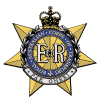 |
Royal Australian
Corps of
Transport |
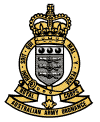 |
Royal Australian
Army
Ordnance
Corps |
|